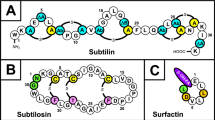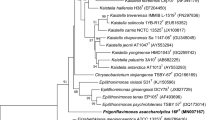Abstract
Novel linear hydroxamate/hydroxycarboxylate siderophores from strains of Pseudomonas cepacia were isolated and named ornibactins. The ornibactins represent modified tetrapeptide siderophores, possessing the sequence l-Orn1(N δ-OH, N Δ-acyl)-d-threo-Asp(β-OH)-l-Ser-l-Orn4(N δ-OH, N δ-formyl)-1,4-diaminobutane. The N δ-acyl groups of Orn1(N δ-OH, N δ-acyl) may vary and represent the three acids 3-hydroxybutanoic acid, 3-hydroxyhexanoic acid and 3-hydroxyoctanoic acid, leading to a mixture of three different ornibactins, designated according to their acyl chain length as ornibactin-C4, ornibactin-C6 and ornibactin-C8. Each of the siderophores is accompanied by a small amount of a more hydrophilic component with a 16 a.m.u. higher mass. The structure elucidation was based on results from gas chromatography amino acid analysis, electrospray mass spectrometry, and one- and two-dimensional nuclear magnetic resonance techniques.
Similar content being viewed by others
Reference
Abdallah MA. 1991 Pyoverdins and pseudobactins. In: Winkelmann G, ed. Handbook of Microbial Iron Chelates. Boca Raton, FL: CRC Press.
Briskot G, Taraz K, Budzikiewicz. 1989 Pyoverdin-type siderophores from Pseudomonas aeruginosa. Liebigs Ann Chem, 1989, 375–384.
Bruins AP, Covey TR, Henion JD. 1987 Ion spray interface for combined liqud chromatography/atmospheric pressure ionisation mass spectroscopy. Anal Chem 59, 2642–2646.
Buyer JS, Wright JM, Leong J. Structure of pseudobactin A 214, a siderophore from bean-deleterious Pseudomonas.Biochemistry 25, 5492–5499.
Cox CD, Rinehart KL, Moore ML, Cook JC. 1981 Pyochelin: novel structure of an iron-chelating growth promotor for Pseudomonas aeruginosa. Proc Nad Acad Sci USA 78, 4256–4260.
Frank H, Nicholson GJ, Bayer E. 1977 Rapid gas chromatographic separation of amino acid enantiomers with a novel chiral stationary phase. J Chromatogr Sci 14, 174–176.
Gläβgen WE, Seitz HU, Metzger J. 1992 High-performance liquid chromatography/electrospray mass spectrometry and tandem mass spectrometry of anthocyanins from plant tissues and cell cultures of Daucus Carota L. Biol Mass Spectrom 21, 271–277.
Hohnadel D, Meyer J-M. 1988 Specificity of pyoverdinemediated iron uptake among fluorescent Pseudomonas strains. J Bacteriol 170, 4865–4873.
Linget C, Stylianou DG, Dell A, Wolff RE, Piemont Y, Abdallah M. 1992 Bacterial siderophores: The structure of a desferribactin produced by a Pseudomonas fluorescens ATCC 13525. Tetrahedron Lett 33, 3851–3854.
Matzanke BF, Ecker DJ, Yang TS, Huynh BH, Müller G, Raymond KN. 1986 Escherischia coli iron enterobactin uptake monitored by Mössbauer spectroscopy. J Bacteriol 167, 674–680.
Maurer B, Müller A, Keller-Schierlein W, Zähner H. 1968 Ferribactin, ein Siderophor aus Pseudomonas fluorescens Migula. Arch Microbiol 60, 326–339.
Meyer JM, Abdallah MA. 1978 The fluorescent pigment of Pseudomonas fluorescens: biosynthesis, purification and physiochemical properties. J Gen Microbiol 107, 319–328.
Meyer JM, Hohnadel D, Hallé F. 1989 Cepabactin from Pseudomonas cepacia, a new type of siderophore. J Gen Microbiol 135, 1479–1487.
Müller L. 1979 Sensitivity enhanced detection of weak nuclei using heteronuclear multiple quantum coherence. J Am Chem Soc 101, 4481–4484.
Oyaizu H, Komagata K. 1982 Grouping of Pseudomonas species on the basis of cellular fatty acid composition and the quinone system with special reference to the existence of 3-hydroxy fatty acids. J Gen Appl Microbiol 29, 17–40.
Stephan H, Freund S, Meyer JM, Winkelmann G, Jung G. 1993 Structure elucidation of the gallium-ornibactin complex by 2D-NMR spectroscopy. Liebigs Ann Chem 43–48.
Taraz K, Tappe R, Schröder H, Hohleicher U, Gwose I, Budzikiewicz H, et al. 1991 Ferribactins—the biogenetic precursors of pyoverdins. Z Naturforsch 46c, 527–533.
Thomson BA, Iribarne JV, Dziedzic PJ. 1982 Liquid ion evaporation/mass spectroscopy/mass spectroscopy for the detection of polar and labile molecules. Anal Chem 54, 2219–2244.
Teintze M, Hossain MB, Barnes CL, Leong J, van der Helm D. 1981 Structure of ferric pseudobactin, a siderophore from a plant growth promoting Pseudomonas. Biochem 20, 6446–6457.
Winkelmann G, ed. 1991 Handbook of Microbial Iron Chelates. Boca Raton, FL: CRC Press.
Yang CC, Leong. 1984 Structure of pseudobactin 7SR1, a siderophore from plant-deleterious Pseudomonas. Biochemistry 23, 3534–3540.
Author information
Authors and Affiliations
Rights and permissions
About this article
Cite this article
Stephan, H., Freund, S., Beck, W. et al. Ornibactins—a new family of siderophores from Pseudomonas . Biometals 6, 93–100 (1993). https://doi.org/10.1007/BF00140109
Received:
Accepted:
Issue Date:
DOI: https://doi.org/10.1007/BF00140109




